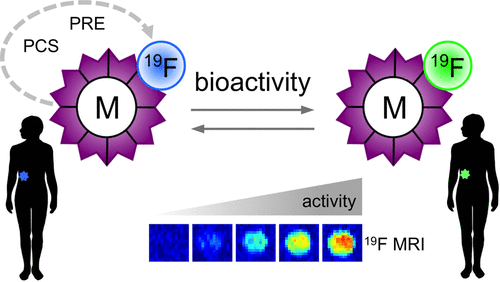当前位置:
X-MOL 学术
›
Acc. Chem. Res.
›
论文详情
Our official English website, www.x-mol.net, welcomes your
feedback! (Note: you will need to create a separate account there.)
19F Magnetic Resonance Activity-Based Sensing Using Paramagnetic Metals.
Accounts of Chemical Research ( IF 16.4 ) Pub Date : 2019-12-06 , DOI: 10.1021/acs.accounts.9b00352 Da Xie 1 , Meng Yu 1 , Rahul T Kadakia 1 , Emily L Que 1
Accounts of Chemical Research ( IF 16.4 ) Pub Date : 2019-12-06 , DOI: 10.1021/acs.accounts.9b00352 Da Xie 1 , Meng Yu 1 , Rahul T Kadakia 1 , Emily L Que 1
Affiliation

|
Fluorine magnetic resonance imaging (19F MRI) is a promising bioimaging technique due to the favorable magnetic resonance properties of the 19F nucleus and the lack of detectable biological background signal. A range of imaging agents have been developed for this imaging modality including small molecule perfluorocarbons, fluorine-rich macromolecules and nanoparticles, and paramagnetic metal-containing agents. Incorporation of paramagnetic metals into fluorinated agents provides a unique opportunity to manipulate relaxation and chemical shift properties of 19F nuclei. Paramagnetic centers will enhance relaxation rates of nearby 19F nuclei through paramagnetic relaxation enhancement (PRE). Further, metals with anisotropic unpaired electrons can induce changes in 19F chemical shift through pseudocontact shift (PCS) effects. PRE and PCS are dependent on the nature of the metal center itself, the molecular scaffold surrounding it, and the position of the 19F nucleus relative to the metal center. One intriguing prospect in 19F magnetic resonance molecular imaging is to design responsive agents that can serve to provide a read out biological activity, including the activity of enzymes, redox activity, the activity of ions, etc. Paramagnetic agents are well suited for this activity-based sensing as metal complexes can be designed to respond to specific biological activities and give a corresponding 19F response that results from changes in the metal complex structure and subsequently PRE/PCS. Broadly speaking, when designing paramagnetic 19F MR biosensors, one can envision that in response to changes in analyte activity, the number of unpaired electrons of the metal changes or the ligand conformation/chemical composition changes. This Account highlights activity-based probes from the Que lab that harness paramagnetic metals to modulate 19F signal. We discuss probes that use conversion from Cu2+ to Cu+ in response to reducing environments to dequench the 19F MR signal. Probes in which oxidants convert Co2+ to Co3+, resulting in chemical shift responses, are also described. Finally, we explore our foray into using Ni2+ coordination switching to furnish probes with different 19F signals when they are converted between 4-coordinate square planar and higher coordination numbers. A major barrier for 19F MR molecular imaging is in vivo application, as signal sensitivity is relatively low, requiring long imaging times to detect imaging agents. Nanoparticle and macromolecular agents show promise due to their higher fluorine density and longer circulation times; however, their analyte scope is limited to analytes that induce cleavage events. A grand challenge for researchers in this area is adapting lessons learned from small molecule paramagnetic probes with promising in vitro activities for the development of probes with enhanced in vivo utility for basic biological and clinical applications.
中文翻译:

使用顺磁性金属进行19F磁共振基于活动的传感。
氟磁共振成像(19F MRI)是一种有前途的生物成像技术,因为19F核具有良好的磁共振特性,并且缺乏可检测的生物学背景信号。已经针对该成像方式开发了一系列成像剂,包括小分子全氟化碳,富氟大分子和纳米颗粒以及含顺磁性金属的试剂。将顺磁性金属掺入氟化剂中提供了独特的机会来控制19F核的弛豫和化学位移特性。顺磁中心将通过顺磁弛豫增强(PRE)来增强附近19F原子核的弛豫率。此外,具有各向异性的不成对电子的金属可通过伪接触位移(PCS)效应引起19F化学位移的变化。PRE和PCS取决于金属中心本身的性质,围绕它的分子支架以及19F原子核相对于金属中心的位置。19F磁共振分子成像的一个引人入胜的前景是设计可提供读出的生物活性的响应剂,包括酶的活性,氧化还原活性,离子的活性等。顺磁性剂非常适合于这种活性,基于金属复合物的传感可以设计为对特定的生物活性做出反应,并给出相应的19F响应,该响应是由于金属复合物结构以及随后的PRE / PCS的变化而产生的。广义地说,当设计顺磁性19F MR生物传感器时,可以预见到,随着分析物活性的变化,金属的未成对电子数改变或配体构象/化学组成改变。该帐户重点介绍了Que实验室基于活动的探针,这些探针利用顺磁性金属调制19F信号。我们讨论了使用探针从Cu2 +转换为Cu +来响应还原环境以消除19F MR信号的方法。还介绍了其中氧化剂将Co2 +转化为Co3 +并导致化学位移响应的探针。最后,我们探索了在4坐标方平面和更高坐标数之间转换时使用Ni2 +配位切换为探针提供不同19F信号的尝试。19F MR分子成像的主要障碍是体内应用,因为信号灵敏度相对较低,需要较长的成像时间才能检测成像剂。纳米颗粒和大分子试剂因其较高的氟密度和更长的循环时间而显示出前景。但是,它们的分析物范围仅限于引起裂解事件的分析物。该领域研究人员面临的一个巨大挑战是,要从具有良好的体外活性的小分子顺磁探针中吸取教训,以开发出具有增强的体内生物学用途的探针,以用于基础生物学和临床应用。
更新日期:2019-12-07
中文翻译:

使用顺磁性金属进行19F磁共振基于活动的传感。
氟磁共振成像(19F MRI)是一种有前途的生物成像技术,因为19F核具有良好的磁共振特性,并且缺乏可检测的生物学背景信号。已经针对该成像方式开发了一系列成像剂,包括小分子全氟化碳,富氟大分子和纳米颗粒以及含顺磁性金属的试剂。将顺磁性金属掺入氟化剂中提供了独特的机会来控制19F核的弛豫和化学位移特性。顺磁中心将通过顺磁弛豫增强(PRE)来增强附近19F原子核的弛豫率。此外,具有各向异性的不成对电子的金属可通过伪接触位移(PCS)效应引起19F化学位移的变化。PRE和PCS取决于金属中心本身的性质,围绕它的分子支架以及19F原子核相对于金属中心的位置。19F磁共振分子成像的一个引人入胜的前景是设计可提供读出的生物活性的响应剂,包括酶的活性,氧化还原活性,离子的活性等。顺磁性剂非常适合于这种活性,基于金属复合物的传感可以设计为对特定的生物活性做出反应,并给出相应的19F响应,该响应是由于金属复合物结构以及随后的PRE / PCS的变化而产生的。广义地说,当设计顺磁性19F MR生物传感器时,可以预见到,随着分析物活性的变化,金属的未成对电子数改变或配体构象/化学组成改变。该帐户重点介绍了Que实验室基于活动的探针,这些探针利用顺磁性金属调制19F信号。我们讨论了使用探针从Cu2 +转换为Cu +来响应还原环境以消除19F MR信号的方法。还介绍了其中氧化剂将Co2 +转化为Co3 +并导致化学位移响应的探针。最后,我们探索了在4坐标方平面和更高坐标数之间转换时使用Ni2 +配位切换为探针提供不同19F信号的尝试。19F MR分子成像的主要障碍是体内应用,因为信号灵敏度相对较低,需要较长的成像时间才能检测成像剂。纳米颗粒和大分子试剂因其较高的氟密度和更长的循环时间而显示出前景。但是,它们的分析物范围仅限于引起裂解事件的分析物。该领域研究人员面临的一个巨大挑战是,要从具有良好的体外活性的小分子顺磁探针中吸取教训,以开发出具有增强的体内生物学用途的探针,以用于基础生物学和临床应用。











































 京公网安备 11010802027423号
京公网安备 11010802027423号